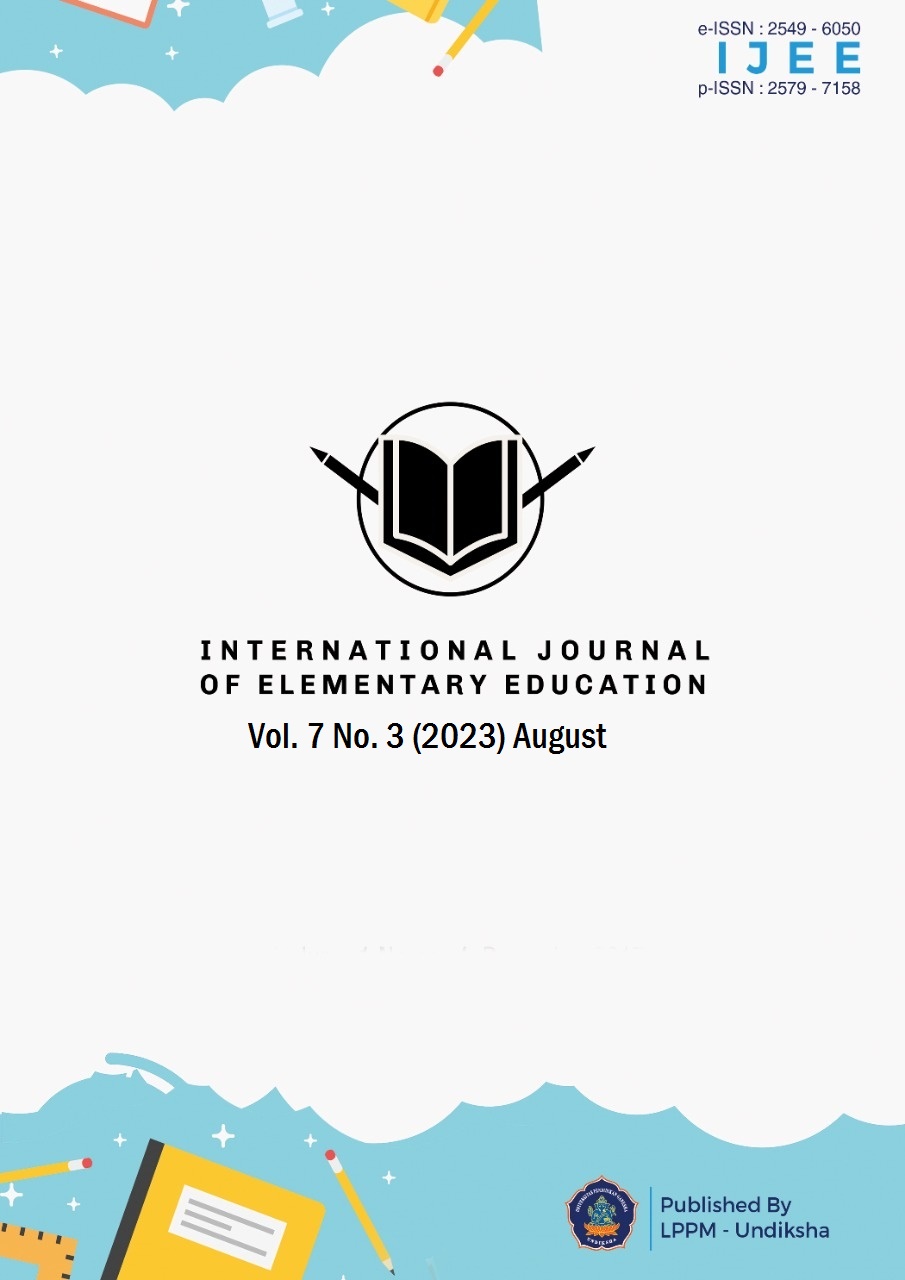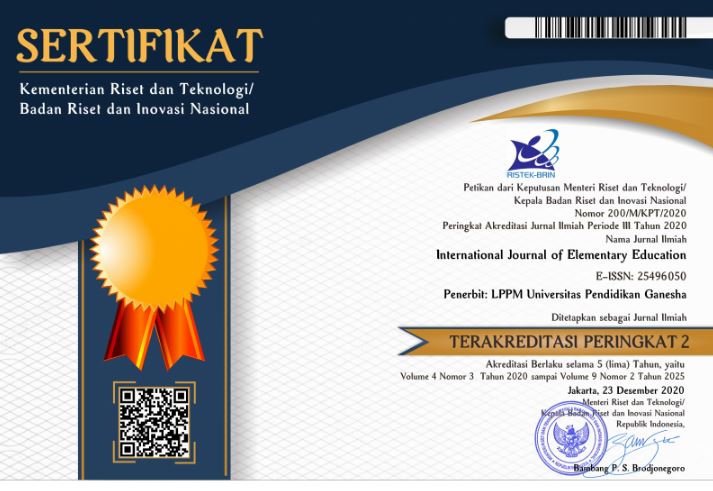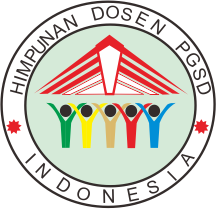Science Learning Videos Based on Contextual Approaches for Grade V Elementary Schools
DOI:
https://doi.org/10.23887/ijee.v7i3.61768Keywords:
Learning Video, Videoscribe, Science LearningAbstract
This development research is motivated by the use of learning media in elementary schools that are not optimal, and teachers still use conventional media, therefore developing learning videos based on a contextual approach to science learning for fifth-grade students. This study aims to develop contextual approach-based video scribe learning videos. This development research used the ADDIE model (Analyze, Design, Development, Implementation, Evaluation). This type of research is research and development. The subjects of this study were three experts, three students, and six students. Data collection methods are observation, interviews, document studies, tests, and questionnaires. The instrument is a rating scale using data analysis techniques, namely descriptive qualitative, quantitative, and inferential statistics. The results of this study are to produce a contextual approach-based video scribe learning video design to increase student interest in learning and to improve the learning outcomes of fifth-grade elementary school students. The average score of media validity is 95%, the average score of content validity is 92%, and the average score of design validity is 95% with a very good predicate, and video scribe learning videos based on a contextual approach is effective in improving the ability of learning outcomes. So, developing a learning video based on a contextual approach to science learning for grade V elementary school students is feasible and effective for improving the learning outcomes of grade V students on water cycle material for fifth-grade elementary school students.
References
Abduh, M. (2015). Pengembangan Perangkat Pembelajaran Tematik-Integratif Berbasis Sosiokultural Di Sekolah Dasar. Jurnal Penelitian Ilmu Pendidikan, 8(1), 44–61. https://doi.org/10.21831/jpipfip.v8i1.4928. DOI: https://doi.org/10.21831/jpipfip.v8i1.4928
Agustina, M., & Apko, H. J. (2021). Kompetensi Guru : Metode Praktik dalam Pembelajaran IPA. At-Tarbawi: Jurnal Pendidikan, Sosial Dan Kebudayaan, 8, 55–70. https://doi.org/10.32505/tarbawi.v13i1.2741 Kompetensi. DOI: https://doi.org/10.32505/tarbawi.v13i1.2741
Aliyyah, R. R., Amini, A., Subasman, I., Sri, E., Herawati, B., & Febiantina, S. (2021a). Upaya Meningkatkan Hasil Belajar Ipa Melalui Penggunaan Media Video Pembelajaran. Jurnal Sosial Humaniora, 12(1), 54–72. https://doi.org/https://doi.org/10.30997/jsh.v12i1.4034.
Aliyyah, R. R., Amini, A., Subasman, I., Sri, E., Herawati, B., & Febiantina, S. (2021b). Upaya Meningkatkan Hasil Belajar Ipa Melalui Penggunaan Media Video Pembelajaran Efforts Toimprove the Science Learning Results Through the Use of Learning Video Media. Jurnal Sosial Humaniora, 12(1), 59. https://doi.org/10.30997/jsh.v12i1.4034.
Amaliyah, N. R. (2021). Penggunaan Model Pembelajaran 4.0 bagi Tenaga Pendidik Sekolah Dasar Jakarta. DIDAKTIKA TAUHIDI: Jurnal Pendidikan Guru Sekolah Dasar, 8(1), 43. https://doi.org/10.30997/dt.v8i1.3342. DOI: https://doi.org/10.30997/dt.v8i1.3342
Antara, I. G. W. S., Suma, K., & Parmiti, D. P. (2022). E-Scrapbook: Konstruksi Media Pembelajaran Digital Bermuatan Soal-soal Higher Order Thinking Skills. Jurnal Edutech Undiksha, 10(1), 11–20. https://doi.org/10.23887/jeu.v10i1.47559.
Apriyanti, N., Razak, R. A., Rahim, S. S. A., Shaharom, M. S. N., & Baharuldin, Z. (2020). Infographic instructional media as a solution and innovation in physics learning for senior high school students in Indonesia. International Journal of Information and Education Technology, 10(10), 773–780. https://doi.org/10.18178/ijiet.2020.10.10.1457. DOI: https://doi.org/10.18178/ijiet.2020.10.10.1457
Bancin, I. K., Mudjiran, M., & Rusdinal, R. (2019). Development of guidance and counseling module on self-regulation of students in social relations. Journal of Counseling and Educational Technology, 2(1), 6. https://doi.org/10.32698/0341. DOI: https://doi.org/10.32698/0341
Busyaeri, A., Udin, T., & Zaenuddin, A. (2016). Pengaruh Penggunaan Video Pembelajaran Terhadap Peningkatan Hasil Belajar Mapel IPA di MIN Kroya Cirebon. Al Ibtida, 3(1). https://doi.org/10.24235/al.ibtida.snj.v3i1.584. DOI: https://doi.org/10.24235/al.ibtida.snj.v3i1.584
Daulay, H. P., Asari, H., Rangkuti, F. R., Islam, U., Sumatera, N., & Medan, U. (2021). Tahfiz Al-Qur ’ an Dalam Kurikulum Pesantren Tahfiz Alquran Nur Aisyah Dan Pesantren Modern Tahfizil Quran Yayasan Islamic Centre Sumatera Utara. TADRIS: Jurnal Pendidikan Islam, 16(1), 20–32. https://doi.org/10.19105/tjpi.v16i1.4554. DOI: https://doi.org/10.19105/tjpi.v16i1.4554
Dwiqi, G. C. S., Sudatha, I. G. W., & Sukmana, A. I. W. I. Y. (2020). Pengembangan Multimedia Pembelajaran Interaktif Mata Pelajaran IPA Untuk Siswa SD Kelas V. Jurnal Edutech Undiksha, 8(2), 33. https://doi.org/10.23887/jeu.v8i2.28934. DOI: https://doi.org/10.23887/jeu.v8i2.28934
Fauzi, R., Anugrahana, A., Betris, P., Ariyanti, Y., Guru, P., & Keguruan, F. (2023). Penerapan Model Pembelajaran Problem Based Learning ( PBL ) untuk Meningkatkan Hasil Belajar IPA tentang Pemahaman Sifat- Sifat Cahaya pada Kelas IV SD Negeri Plaosan 1. Jurnal Pendidikan Tambusai, 7(1), 2569–2574. https://doi.org/https://doi.org/10.31004/jptam.v7i1.5605. DOI: https://doi.org/10.31004/jptam.v7i1.5605
Fransisca, I. (2018). Pengembangan Media Pembelajaran Video Berbasis Sparkol Videoscribe Pada Pelajaran Ipa Dalam Materi Tata Surya Kelas Vi Sd. Jurnal Penelitian Pendidikan Guru Sekolah Dasar, 6(11), 1916–1927. https://jurnalmahasiswa.unesa.ac.id/index.php/39/article/view/24661.
Hadi, S., & Novaliyosi. (2019). TIMSS Indonesia (Trends in International Mathematics and Science Study). Prosiding Seminar Nasional & Call For Papers, 562–569. http://jurnal.unsil.ac.id/index.php/sncp/article/view/1096.
Hendi, A., Caswita, C., & Haenilah, E. Y. (2020). Pengembangan Media Pembelajaran Interaktif Berbasis Strategi Metakognitif untuk Meningkatkan Kemampuan Berpikir Kritis siswa. Jurnal Cendekia : Jurnal Pendidikan Matematika, 4(2), 823–834. https://doi.org/10.31004/cendekia.v4i2.310. DOI: https://doi.org/10.31004/cendekia.v4i2.310
Hermansyah. (2021). Manajemen Lembaga Pendidikan Sekolah Berbasis Digitalisasi Di Era Covid-19. Jurnal Studi Pendidikan, 7(1), 28–46. https://doi.org/https://doi.org/10.47625/fitrah.v12i1.320. DOI: https://doi.org/10.47625/fitrah.v13i1.369
Imanuel, S. A. (2015). Kesulitan Belajar IPA Peserta Didik Sekolah Dasar. Vox Edukasi, 6(2), 143–155. https://doi.org/https://doi.org/10.31932/ve.v6i2.106.
Indayani, R., & Wicaksono, I. (2021). Pengaruh videoscribe terhadap keterampilan berpikir kritis peserta didik pada pembelajaran ipa. Jurnal Pendidikan Sains Dan Matematika, 9(37), 107–115. https://doi.org/https://doi.org/10.23971/eds.v9i2.2008. DOI: https://doi.org/10.23971/eds.v9i2.2008
Jundu, R., Nendi, F., Kurnila, V. S., Mulu, H., Ningsi, G. P., & Ali, F. A. (2020). Pengembangan Video Pembelajaran IPA Berbasis Kontekstual Di Manggarai Untuk Belajar Siswa Pada Masa Pandemic Covid-19. LENSA (Lentera Sains): Jurnal Pendidikan IPA, 10(2), 63–73. https://doi.org/10.24929/lensa.v10i2.112. DOI: https://doi.org/10.24929/lensa.v10i2.112
Juniari, I. G. A. O., & Putra, M. (2021). Upaya Meningkatkan Semangat Belajar Siswa Melalui Media Pembelajaran Multimedia Interaktif pada Pelajaran IPA Kelas V Sekolah Dasar. Jurnal Edutech Undiksha, 8(1), 140–148. https://ejournal.undiksha.ac.id/index.php/JEU/article/download/33091/18780/88499. DOI: https://doi.org/10.23887/jeu.v9i1.33091
Kurniawan, D., Wahyuningsih, T., & Pangadongan, F. V. (2019). Pelatihan Kepada Guru SD untuk Mengajarkan Konsep Luas Bidang Datar dengan Menggunakan MEQIP ( Mathematic Eduation Quality Improvement ). International Journal of Community Service Learning, 3(2), 56–62. https://doi.org/https://doi.org/10.23887/ijcsl.v3i2.17812. DOI: https://doi.org/10.23887/ijcsl.v3i2.17812
Luh, N., Merta, P., Wibawa, I. M. C., Pgsd, J., & Ganesha, U. P. (2019). Pengaruh Model Pembelajaran Make A Match Terhadap Motivasi Belajar Ilmu Pengetahuan Alam. MIMBAR PGSD Undiksha, 7(3), 189–197. https://doi.org/https://doi.org/10.23887/jjpgsd.v7i3.19389.
Maison, M., Kurniawan, D. A., & Pratiwi, N. I. S. (2020). Pendidikan Sains di Sekolah Menengah Pertama Perkotaan: Bagaimana Sikap dan Keaktifan Belajar Siswa terhadap Sains? Jurnal Inovasi Pendidikan IPA, 6(2), 135–145. https://doi.org/10.21831/jipi.v6i2.32425. DOI: https://doi.org/10.21831/jipi.v6i2.32425
Melani, W. W., Tahir, M., & Khair, B. N. (2022). Model Video Pembelajaran IPA Pada Kelas IV. Journal of Classroom Action Research, 4(2), 1–5. https://doi.org/10.29303/jcar.v4i1.1609.
Moto, M. M. (2019). Pengaruh Penggunaan Media Pembelajaran dalam Dunia Pendidikan. Indonesian Journal of Primary Education, 3(1), 20–28. https://doi.org/10.17509/ijpe.v3i1.16060. DOI: https://doi.org/10.17509/ijpe.v3i1.16060
Muchtar, F. Y., Nasrah, N., & Ilham S, M. (2021). Pengembangan Multimedia Interaktif Berbasis I-Spring Presenter untuk Meningkatkan Keterampilan Berpikir Kritis Siswa Sekolah Dasar. Jurnal Basicedu, 5(6), 5520–5529. https://doi.org/10.31004/basicedu.v5i6.1711. DOI: https://doi.org/10.31004/basicedu.v5i6.1711
Mushfi, M., & Iq, E. (2020). Modernisasi Pendidikan Agama Islam Di Era Revolusi Industri 4 . 0 Sekolah Tinggi Islam Blambangan ( STIB ) Banyuwangi Sekolah Tinggi Islam Blambangan ( STIB ) Banyuwangi. Jurnal Sosial Dan Keagamaan, 09(1), 42–62. https://doi.org/https://doi.org/10.1017/CBO9781107415324.004. DOI: https://doi.org/10.29062/mmt.v9i1.64
Novitama, M. A., & Simamora, A. H. (2022). Video Tutorial Pembelajaran Berbasis Kontekstual pada Mata Pelajaran Kerja Bengkel dan Gambar Teknik Kelas X Teknik Audio Visual. Jurnal Edutech Undiksha, 10(2), 195–204. https://doi.org/https://doi.org/10.23887/jeu.v10i2.53010 Video. DOI: https://doi.org/10.23887/jeu.v10i2.53010
Octavyanti, N. P. L., & Wulandari, I. G. A. A. (2021). Pengembangan Video Pembelajaran Berbasis Pendekatan Kontekstual Pada Mata Pelajaran Matematika Kelas IV SD. Jurnal Edutech Undiksha, 9(1), 66–74. https://doi.org/10.23887/jeu.v9i1.32223. DOI: https://doi.org/10.23887/jeu.v9i1.32223
Permatasari, I. S., Hendracipta, N., & Pamungkas, A. S. (2019). Pengembangan Media Pembelajaran Video Animasi Hands Move Dengan Konteks Lingkungan Pada Mapel Ips. Terampil : Jurnal Pendidikan Dan Pembelajaran Dasar, 6(1), 34–48. https://doi.org/10.24042/terampil.v6i1.4100. DOI: https://doi.org/10.24042/terampil.v6i1.4100
Putri, L. G. R. A., Japa, I. G. N., & Riastini, P. N. (2021). Media Pembelajaran Videoscribe-Hots Bermuatan IPA Pada Topik Struktur Dan Fungsi Bagian Tumbuhan Kelas IV SD. Mimbar Ilmu Undiksha, 26(3), 451–460. https://doi.org/10.23887/mi.v26i3.38830. DOI: https://doi.org/10.23887/mi.v26i3.38830
Rahayu, R., & Ismawati, R. (2019). Pembelajaran Berbasis Masalah Pada Materi Pencemaran Lingkungan Sebagai Upaya Melatih Kemampuan Pemecahan Masalah Pada Siswa Smk. Indonesian Journal of Natural Science Education (IJNSE), 2(2). https://doi.org/10.31002/nse.v2i2.706. DOI: https://doi.org/10.31002/nse.v2i2.706
Rikarno, R., Maimori, R., Yuliani, T., Limo, N., Kab, K., & Datar, T. (2021). Mendesain Video Yang Menarik Pembelajaran Membaca Al-Quran Di Era New Normal. Jurnal Seni Desain Dan Budaya, 6(2), 57–63. https://doi.org/https://doi.org/10.36982/jsdb.v6i2.1710. DOI: https://doi.org/10.36982/jsdb.v6i2.1710
Rima, R. E., Wuryandini, S. S., & Diyah, R. T. (2023). Penerapan Model Project Based Learning Pada Kurikulum Merdeka Dalam Meningkatkan Pemahaman Konsep Ipas Pada Siswa Kelas IV SD Negeri Pandeanlamper 1 Rima. Jurnal Pendidikan Dan Konseling, 5(2), 1450–1456. https://doi.org/https://doi.org/10.31004/jpdk.v5i2.12869.
Saputri, R., Eko, S., Widoyoko, P., & Anjarini, T. (2023). Ensiklopedia Digital Berbasis Creative Thinking Terintegrasi Karakter pada Materi IPA Kelas 5 SD. Edukasiana: Jurnal Inovasi Pendidikan, 2(1), 47–55. https://doi.org/10.56916/ejip.v2i1.266. DOI: https://doi.org/10.56916/ejip.v2i1.266
Sari, N. F. (2017). Perbandingan Hasil Belajar Siswa yang Diajar Menggunakan Model Pembelajaran Quantum Teaching dengan Model Pembelajaran Langsung (Direct Instruction) Pada Sub Bab Materi Pokok Sistem Respirasi Pada Manusia di Kelas XI SMA Swasta Medan Putri Tahun Pembelaja. Edu Science, 4(2), 18–24. https://doi.org/10.36987/jes.v4i2.935.
Setiawan, H. R., Rakhmadi, A. J., & Raisal, A. Y. (2021). Pengembangan Media Ajar Lubang HHitam Menggunakan Model Pengembangan ADDIE. Jurnal Kumparan Fisika, 4(2), 112–119. https://doi.org/10.33369/jkf.4.2.112-119. DOI: https://doi.org/10.33369/jkf.4.2.112-119
Sholeh, M. (2019). Pengembangan Media Pop-Up Book Berbasis Budaya Lokal Keberagaman Budaya Bangsaku Siswa Kelas IV Sekolah Dasar. Jurnal Gentala Pendidikan Dasar, 4(1), 138–150. https://doi.org/10.22437/gentala.v4i1.6979. DOI: https://doi.org/10.22437/gentala.v4i1.6979
Suci Rahmadani, Mufarizuddin, Y. Y. K. (2023). Analysis of factors affecting learning activities of elementary school students (qualitative descriptive research on fifth grade students of sd negeri 004 bangkinang kota). Jurnal Muassis Pendidikan Dasar, 2(1), 45–53. https://doi.org/https://doi.org/10.55732/jmpd.v2i1.37. DOI: https://doi.org/10.55732/jmpd.v2i1.37
Suryaningtyas, A., Kimianti, F., & Prasetyo, Z. K. (2020). Developing Science Electronic Module Based on Problem-Based Learning and Guided Discovery Learning to Increase Critical Thinking and Problem-Solving Skills. 401(Iceri 2019), 65–70. https://doi.org/10.2991/assehr.k.200204.013. DOI: https://doi.org/10.2991/assehr.k.200204.013
Syarifuddin, Ilyas, J. B., & Sani, A. (2021). Pengaruh Persepsi Pendidikan dan Pelatihan Sumber Daya Manusia pada Kantor Dinas di Kota Makassar. Bata Ilyas Educational Management Review, 1(2), 51–56. https://doi.org/https://doi.org/10.37531/biemr.v1i2.102.
Trust, T., & Pektas, E. (2018). Using the ADDIE Model and Universal Design for Learning Principles to Develop an Open Online Course for Teacher Professional Development. Journal of Digital Learning in Teacher Education, 34(4), 219–233. https://doi.org/10.1080/21532974.2018.1494521. DOI: https://doi.org/10.1080/21532974.2018.1494521
Utami, I. K., & Abdulah, M. H. (2020). Pengembangan Media Ular Tangga dalam Pembelajaran Tema Daerah Tempat Tinggalku Peserta Didik Kelas IV Sekolah Dasar. Jurnal Pendidikan Guru Sekolah Dasar, 8(3), 581–590. https://ejournal.unesa.ac.id/index.php/jurnal-penelitian-pgsd/article/view/35321.
Wedayanti, L. A., & Wiarta, I. W. (2022). Multimedia Interaktif Berbasis Problem Based Learning Pada Muatan Matematika Kelas IV SD. Mimbar PGSD Undiksha, 10(1), 113–122. https://doi.org/10.23887/jjpgsd.v10i1.46320. DOI: https://doi.org/10.23887/jjpgsd.v10i1.46320
Wulan, N. P. J. D., Ignatius., Suwatra, I. W., & Jampel, I. N. (2019). Pengembangan Media Permainan Edukatif Teka-Teki Silang Berorientasi Pendidikan Karakter pada Mata Pelajaran IPS. Jurnal EDUTECH Universitas Pendidikan Ganesha, 7(1), 66–74. https://doi.org/10.23887/jeu.v7i1.20009.
Wulan, Ni Putu Jati Dinar, Suwatra, I. I. W., & Jampel, I. N. (2019). Pengembangan media permainan edukatif teka- teki silang berorientasi pendidikan karakter pada mata pelajaran ips. Jurnal EDUTECH Universitas Pendidikan Ganesha, 7(1), 66–74. https://doi.org/https://doi.org/10.23887/jeu.v7i1.20009.
Xie, F., Song, H., & Zhang, H. (2023). Research on Light Comfort of Waiting Hall of High-Speed. MDPI, 13. https://doi.org/https://doi.org/10.3390/buildings13041105. DOI: https://doi.org/10.3390/buildings13041105
Yana, F. T. M. R., & Andy, N. S. (2019). Dampak Perkembangan Teknologi Informasi dan Komunikasi Terhadap Perilaku Moral Remaja di SMA Negeri 3 Kota Kupang. Jurnal Kependidikan, 5(1), 61–74. https://doi.org/https://doi.org/10.33394/jk.v5i1.1395. DOI: https://doi.org/10.33394/jk.v5i1.1395
Zain, A. A., & Pratiwi, W. (2021). Analisis Kebutuhan Pengembangan Media PowerPoint Interaktif Sebagai Media Pembelajaran Tematik Kelas V SD. Elementary School: Jurnal Pendidikan Dan Pembelajaran Ke-SD-An, 8(1), 75–81. http://download.garuda.kemdikbud.go.id/article.php?article=2997005&val=27000&title=analisis kebutuhan pengembangan media powerpoint interaktif sebagai media pembelajaran tematik kelas v sd. DOI: https://doi.org/10.31316/esjurnal.v8i1.1205
Zamil, M. R. R., Hariyono, E., & Prahani, B. K. (2021). Profile of Implementation Direct Instruction and Physics Problem Solving Skills of Senior High School Students. Jurnal Ilmiah Pendidikan Fisika, 5(3), 292–304. https://doi.org/https://doi.org/10.20527/jipf.v5i3.3895. DOI: https://doi.org/10.20527/jipf.v5i3.3895
Downloads
Published
How to Cite
Issue
Section
License
Copyright (c) 2023 Natalia Wedaswari

This work is licensed under a Creative Commons Attribution-ShareAlike 4.0 International License.
Authors who publish with the International Journal of Elementary Education agree to the following terms:
- Authors retain copyright and grant the journal the right of first publication with the work simultaneously licensed under a Creative Commons Attribution License (CC BY-SA 4.0) that allows others to share the work with an acknowledgment of the work's authorship and initial publication in this journal.
- Authors are able to enter into separate, additional contractual arrangements for the non-exclusive distribution of the journal's published version of the work (e.g., post it to an institutional repository or publish it in a book), with an acknowledgment of its initial publication in this journal.
- Authors are permitted and encouraged to post their work online (e.g., in institutional repositories or on their website) prior to and during the submission process, as it can lead to productive exchanges, as well as earlier and greater citation of published work. (See The Effect of Open Access)









